#indian vegetarian recipe
Text
Creamy Paneer Kofta Curry - Indulgent North Indian Recipe
Paneer Malai Kofta - rich, creamy North Indian comfort food.
Paneer Malai Kofta is a classic North Indian comfort food that combines crispy paneer dumplings (koftas) with a rich, creamy, and luxurious gravy. Whether you’re celebrating a special occasion or just craving something indulgent, this dish brings gourmet Indian flavors to your dinner table.
Nutritional Information (Per Serving)
Calories: Approximately 175
Fat: 13g
Sodium:…

View On WordPress
#comfort food#creamy curry#Indian vegetarian recipe#North Indian cuisine#paneer dumplings#Paneer Malai Kofta#panvel#restaurant-style kofta#thepanvelite
1 note
·
View note
Text

Craving a fun and delicious appetizer? Look no further than cheese corn balls! This guide unlocks the secrets to creating these delightful bites at home. We'll explore classic and restaurant-style recipes, from baked to fried options. Discover the perfect blend of cheese and corn, along with additional ingredient ideas to customize your flavor profile. Get ready to impress your guests with homemade cheese corn balls!
#indian food#indian cuisine#indian dishes#vegetarian recipes#Indian vegetarian recipe#cheese corn ball#Indian food recipe
0 notes
Text
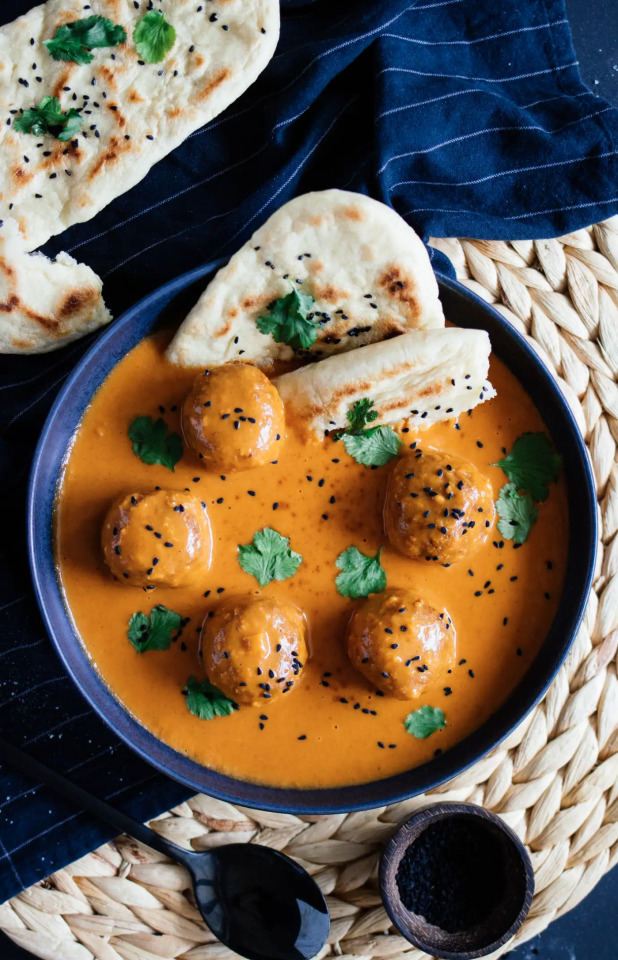
Vegan Falafel Curry With Naan Bread
#food#dinner#recipe#recipes#vegan#veganism#vegetarian#savoury#curry#falafel#falafels#naan#naan bread#tasty#foodporn#food porn#indian
176 notes
·
View notes
Text
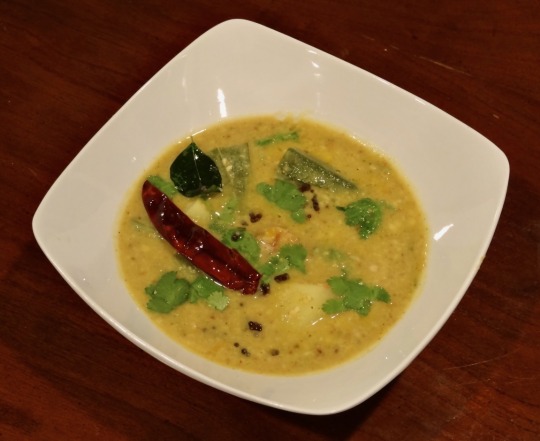
[ID: A bowl of a bright yellow stew topped with cilantro, mustard seed, chili, and curry leaf. End ID]
ಉಡುಪಿ ಸಾಂಬಾರ್ / Udupi sambar
A sambar is a lentil-and-vegetable stew distinguished by the use of a particular spice blend (Hindi: सांबर मसाला "sāmbār masālā," "sambar spice"; Kannada: ಸಾಂಬಾರ್ ಪುಡಿ "sāmbār puḍi," "sambar powder"). Sambars are a staple of South Indian and Sri Lankan cooking, sometimes made in households for multiple meals a week. The word "sambar" can be traced back to the Sanskrit सम्भार "sambhārá," "collection of things required for a particular purpose”; “spices."
The lentil used in sambar dishes is usually tur dal (split pigeon peas), though arhar dal, tuvur dal, or even blends containing masur or mung dal may be used, depending on the cook or the region. Vegetables also vary between combinations of okra, potato, ash gourd (petha), bottle gourd (doodhi / lauki), drumstick (saijan ki phalli), beetroot, tomato, carrot, pumpkin, brinjal, and pearl onions, among others. The sambar masala fries chilis, curry leaves, dal, and various spices including cumin, coriander, and fenugreek, then grinds them into a spicy, earthy, fragrant blend.
This recipe makes a sambar in the style of ಉಡುಪಿ (Udupi) cuisine—a subdivision of the cuisine of the ತುಳುವ (Tuluva) people localised in the Udupi District of Karnataka, a southeastern coastal state of India. (Tuluva cuisine is also commonly found in Dakshina Kannada, Karnataka, and Kasaragod, Kerala). In the Udupi region, sambar may be known as "ಕೊಡೆಲ್" "kodhel"; perhaps related to "ಕಡಲೆ" "kadhale" "Bengal gram"; or "ಹುಲಿ" "huḷi"; "tartness." Udupi huli has coconut oil and jaggery as its primary distinguishing features: the jaggery's deep sweetness and the earthy pungency of unrefined coconut oil combine with the spice of the chilis and the sour fruitiness of the tamarind to create a complex, flavorful, well-balanced dish.
Udupi huli may be further divided into a few major types. ಮಸಾಲೆ ಹುಳಿ ("masāla huḷi") contains shredded coconut and vegetables; ಬೋಳು ಹುಳಿ ("bolu huḷi") contains vegetables, but omits the coconut.
Hotel-style masala huli recipes typically add a lot of jaggery to produce a distinct sweetness; cut back on the amount of coconut included; and contain onion and garlic. The other main type of masala huli—“temple style”—is sattvic (from Sanskrit "सत्त्व" "sattva": "goodness," "essence," "existence"), which in this context means that onions and garlic are excluded.
A sattvic diet in Hinduism centres around the concept of maintaining sattva by eating only pure and mild (sattvic) foods, and omitting tamasic (“dark,” "inert," "destructive"; from Sanskrit तमस् "tamas") and rajasic ("exciting," "passionate," from Sanskrit रजस् "rajas") ones. The concepts of sattva, tamas, and rajas (the गुण "guṇa" system) are central to the construction of caste: the degree to which each person innately inherits each quality supposedly determines their possession of characteristics including honesty, intelligence, and goodness (sattva), stupidity and lack of creativity (tamas), and passion and pridefulness (rajas); the possession of these characteristics in turn determines their rightful place in a professional and social hierarchy. The association of certain foods with certain qualities thus links diet to caste: a distinction in diet is one of the methods by which those belonging to upper castes maintain and police caste boundaries.
This recipe makes enough pudi for one pot of sambar. Traditionally, sambar pudi is created fresh each time the dish is made, but many households make large batches and store them. In this case, omit the coconut; or, use dried coconut and store the masala in the refrigerator.
Recipe under the cut!
Patreon | Paypal | Venmo
Ingredients:
Serves 4-6.
For the sambar:
2 cups chopped vegetables
1 red onion, sliced*
1 cup (200g) yellow split pigeon peas / tur dal / ತೂರ್ ದಾಲ್ (ಹಳದಿ ಸ್ಪ್ಲಿಟ್ ಪಾರಿವಾಳದ ಬಟಾಣಿ)
4 cups (1 litre) water, or as needed
1/4 tsp ground turmeric / haldi / ಅರಿಶಿನ
2 tsp table salt
2 tsp jaggery / gur / ಬೆಲ್ಲ*
1/4 cup (60mL) tamarind pulp (from 1 Tbsp dried tamarind / imlie / ಹುಣಸೆಹಣ್ಣು)
2 tsp unrefined coconut oil / nariyal ka tel / ತೆಂಗಿನ ಎಣ್ಣೆ
Ingredient list format is English / Hindi (Latin transcription) / Kannada. The Hindi is provided for convenience while shopping.
Udupi sambar usually uses any of: gourd, brinjal (Indian eggplant), pumpkin, dumstick (saijan ki phalli), and okra. Pearl onion is not usually used in this region, but you can add whatever you want, according to taste.
*For a hotel-style sambar, include the onion; increase the jaggery to 2 Tbsp.
For the spice paste / sambar masala / ಸಾಂಬಾರ್ ಪುಡಿ ("sambar pudi"):
1/2 Tbsp split Bengal gram / chana dal / ಹಳದಿ ಸ್ಪ್ಲಿಟ್ ಗ್ರಾಂ
2 tsp split black gram / urad dal chilka / ಸ್ಪ್ಲಿಟ್ ಬ್ಲ್ಯಾಕ್ ಗ್ರಾಂ
2 tsp coriander seeds / dhaniya / ಕೊತ್ತಂಬರಿ ಬೀಜದ
1/2 tsp fenugreek seeds / methi / ಮೆಂತ್ಯ
1 tsp cumin seeds / jeera / ಜೀರಿಗೆ
1 tsp ground turmeric
5-6 curry leaves / kari pati / ಕರಿಬೇವು
3-4 Byadagi or other dried red chilis / byadagi mirch / ಬ್ಯಾಡಗಿ ಮೆಣಸಿನಕಾಯಿ
4 cloves garlic, skins on*
Large pinch asafoetida / hing / ಇಂಗು
1 cup (100g) fresh coconut (about one coconut)*
1/2 cup (120mL) water
While the ratio of ingredients in Udupi sambar pudi vary slightly, the ingredients themselves are almost always consistent.
*For a hotel-style sambar, include the garlic, and decrease the coconut in the sambar masala to 1/4 or 1/2 cup (25-50g).
The grams and pulses in this pudi have many different names. You can find them in a halal or South Asian grocery store; look on the bag for the Hindi names (since they have been transcribed into Latin, the spelling may vary from what you see here).
The urad dal you find may be husked, and thus yellow instead of black; these will work just as well.
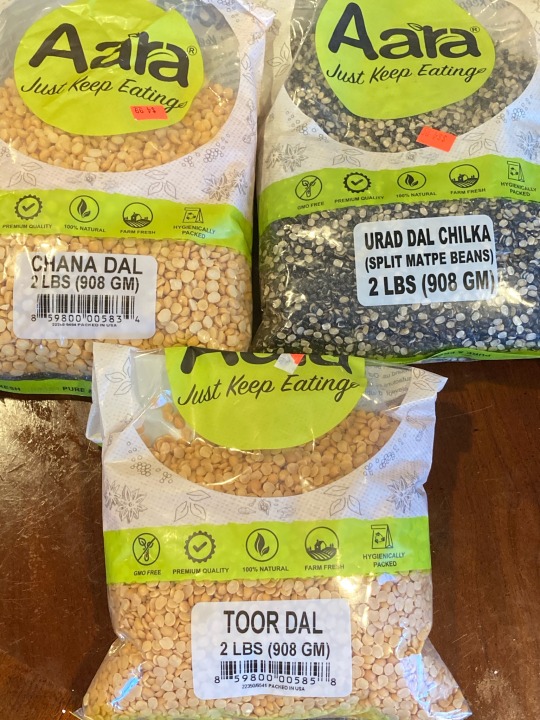
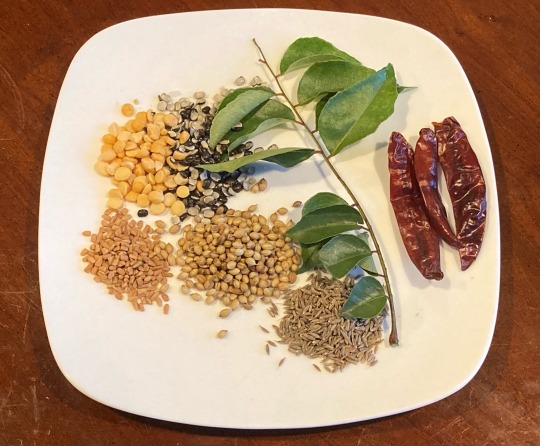
For the tempering / tadka / ಹದಗೊಳಿಸುವ:
2 Tbsp unrefined coconut oil
2 red chilis
8 curry leaves
1 tsp brown mustard seeds / rai / ಸಾಸಿವೆ ಬೀಜಗಳು
Recipes from north Karnataka may add cumin and whole, unpeeled garlic cloves to the tempering.
Instructions:
For the sambar pudi:
1. Break open the coconut and remove and shread its flesh.
If using a whole dried coconut, break into the shell with the wrong side of a hammer and pry open. Break into a few smaller pieces and peel with a vegetable peeler until the skin is removed from the white flesh, wearing something to protect your hand. Soak in warm water for several minutes to soften, and then grate or food process.

2. Heat 2 Tbsp of coconut oil in a skillet on medium-low. Add asafoetida and fry for 30 seconds, until no longer raw-smelling. Add dal and fry, stirring often, for 30 seconds until golden brown; add coriander, mustard, fenugreek, and cumin seeds and fry until fragrant.
3. Add curry leaves and fry until wilted, then add garlic and dried chilis and fry another 30 seconds to a minute, until fragrant.
4. Add coconut and fry, stirring often, for another few minutes until a shade darker. Add turmeric and stir.
5. Grind all ingredients into a paste in a mortar and pestle, then mix in about 1/2 cup water to loosen (if using dried coconut, you may need more water).
Or, put all ingredients along with 1/2 cup water into a blender or food processor and process until a relatively smooth paste forms.
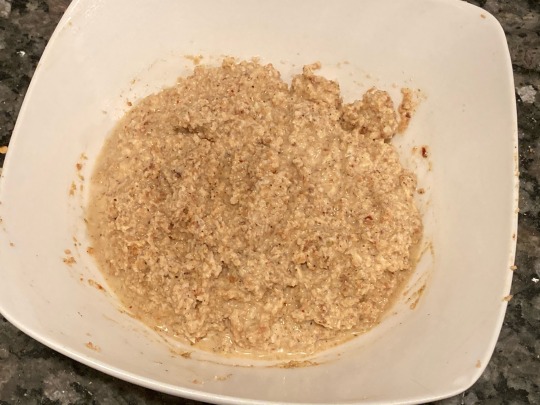
For the sambar:
1. Wash tur dal to remove excess starch. Simmer dal with 2 cups water, 1/4 tsp ground turmeric, and 1 tsp coconut oil for about 30 minutes until very tender. Mash until relatively smooth with a wooden spoon or bean masher, or process briefly with an immersion blender.
You may soak the dal in water after rinsing them to reduce the cooking time, but it is not necessary.
2. Meanwhile, make the tamarind paste. Soak 1 Tbsp tamarind dried pulp in 1/4 cup hot water for 20-30 minutes. Squeeze the tamarind into the water to extract the pulp. Discard the tamarind seeds and husk. Optionally, depending on your preferred texture, push the mixture through a metal sieve.
3. Prepare vegetables. Slice the onion; remove ends of okra and drumsticks and cut into 2-inch pieces; quarter tomatoes; quarter brinjal; peel pumpkin and cut into cubes; peel and cube potatoes.
4. If using onion, add a teaspoon of coconut oil to a large pot and fry until translucent.
5. In the same pot, boil vegetables in just enough water to cover, along with a pinch of salt, until they are beginning to soften.
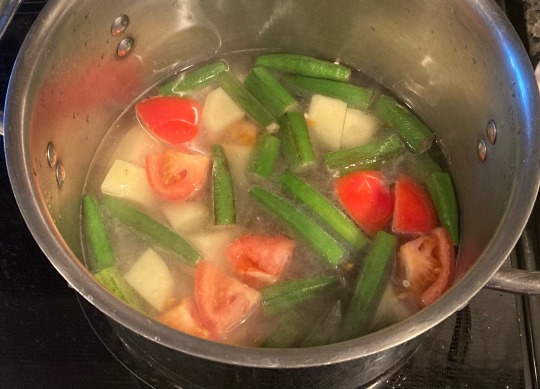
Some recipes call for the vegetables to be boiled, and others call for them to be steamed. I prefer boiling, since it produces a nice savory broth.
6. Mix vegetables, dal, tamarind, jaggery, sambar pudi, and salt to taste and simmer 5-10 minutes to allow flavors to combine and vegetables to cook under tender. Add water as needed. Remove from heat and stir in cilantro. Taste and adjust salt.
The final sambar should be pourable, like a thick soup—Karnataka sambar is typically thinner in consistency than Tamil Nadu versions.
For the tadka:
1. Heat coconut oil in a small skillet on medium heat. Add tempering ingredients and fry, stirring often, until chilis and curry leaves are a couple shades darker and the mixture is fragrant.
2. Pour the oil and tempering ingredients into the sambar and stir in. If you like, retain some of the tadka as a garnish to serve.
3. Serve warm, in individual bowls, alongside long-grain white rice. To eat drumsticks, scoop the center out and eat it; the tough outer rind is left.
If you intend to save some sambar, it's a good idea to make just enough tadka for what you plan to eat that day, and then make fresh tadka to pour over the reheated leftovers.
107 notes
·
View notes
Text
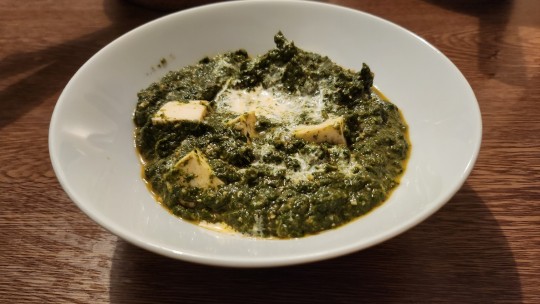
Hackle-lo and Scuttle Curry
One of the Telvanni Peninsula's most famous dishes, this simple, mild curry of hackle-lo and firm scuttle is delightfully rich and flavourful, yet simultaneously mild and balanced. Serve with wickwheat flatbread or steamed saltrice. Suitable for vegetarians! For a vegan version, replace paneer with tofu, and butter with coconut oil.
You will need:
225g paneer, cut into generous cubes (Indian cottage cheese CANNOT be substituted with regular cottage cheese! If you can't find paneer, use tofu or fresh mozzarella)
125g baby spinach
2 onions, finely diced
2 tbsp concentrated tomato purée
3 tbsp unsalted, unroasted cashews
1 tsp ginger paste
5 cloves garlic, minced
2-3 green chilis, sliced (like finger chilis or even fresh jalapeños), optional if you prefer it mild
1/2 tsp garam masala
2 cloves
2 cardamom pods, crushed lightly
1 tsp cumin
1 tbsp cinnamon
2 tbsp sugar
175ml water
2 tbsp butter
Coconut oil or vegetable oil
Salt and pepper, to taste
Cream, to serve (optional)
Method:
Combine the cloves, cardamom, cumin, and cinnamon in a pot, and gently cook on low heat with the butter and 1 tbsp coconut oil to release the aroma.
Toss in half the onions and fry until golden brown. Add the ginger paste and minced garlic, and continue to fry until they release their aroma. Add the tomato purée, salt and pepper, sugar, and garam masala. Continue stirring until well combined, then remove from heat, add the water, and purée until smooth with a blender or immersion blender. Set aside.
In a wok or large pot, fry the rest of the onions and chilis until glossy and aromatic. Add the spinach, and gently stir fry until the spinach has wilted and released most of its water. The spinach should still be green and not overcooked.
Transfer to a blender or use an immersion blender once again. Add the cashews. Purée until smooth and transfer to a bowl.
Put the tomato purée mix back on the heat and bring to a gentle bubble, then immediately remove from the heat and add the spinach purée. Stir until totally incorporated. Throw in your paneer and gently stir until well coated in curry.
Serve hot immediately, with either basmati rice or naan/roti on the side. Drizzle with cream to serve, if desired.
#the elder scrolls#tes#food#cooking#Recipe#Recipes#Indian#Indian food#Palak paneer#Saag paneer#Cheese#vegetarian recipe#vegetarian recipes#vegan cooking#Vegan#Vegan food#Hackle-lo and Scuttle Curry#Curry#World building#worldbuilding
246 notes
·
View notes
Text
Paneer and Vegetable Korma

Usually korma is made with chicken, but I wanted to try something vegetarian. I'm getting a little sick of chicken! My brother absolutely refuses to eat anything without meat in it, but he liked this just fine. Finally a reprieve from chicken!
Ingredients
♡ 1/4 cup olive or coconut oil
♡ 1 large onion, diced
♡ 4 cloves garlic, minced
♡ 1 tsp ginger paste
♡ 1 small tomato, diced (optional)
♡ 3/4 cup greek yogurt
♡ Bay leaf
♡ 1 tsp ground cumin
♡ 1/4 tsp ground coriander
♡ 1/4 tsp ground cardamon
♡ 1/8 tsp black pepper
♡ 1/8 tsp ground cloves
♡ 1/8 tsp ground cinnamon
♡ 1/2 tsp chili powder
♡ 1/2 tsp turmeric
♡ 1/2 tsp paprika
♡ 1 tsp garam masala
♡ salt, to taste
♡ 1/2 cup carrots, diced
♡ 1 cup potatoes, diced
♡ 1 large zucchini, sliced
♡ Paneer or tofu
♡ 1/2 cup to 3/4 cup water
♡ Cilantro to top
Inatructions
☆ Heat oil in large pan at medium heat. Add onions and stir
☆ Heat onions until almost translucent, then add garlic and ginger paste
☆ Once all items from pan are cooked, transfer them to a food processor or blender
☆ Add tomato and yogurt to the food processor and blend until smooth
☆ Add the blended mixture back into the pan an stir in spices. Saute until mixture reaches a simmer
☆ Add in vegetables and paneer/tofu. Let simmer for 10-12 minutes
☆ Add 1/2 to 3/4 cup water, depending on your desired consistency. Stir and let simmer for 2 to 3 minutes.
☆ Serve topped with cilantro
#gluten free#my recipe#my recipes#gluten free recipe#gluten free recipes#vegetarian#gluten free indian food#indian food#nut free#egg free#celiac#curry
33 notes
·
View notes
Text


Delicious desi food found at the shared table, found in Hastings every Wednesday
#cooking#recipes#tasty#vegan#veganfood#veganism#baked goods#bakery#baking#home cooking#india#indian#indian food#desi tumblr#foodporn#foodie#food#eating rocks#food photography#foodgasm#foodpics#resturant#vegancomfortfood#veganized#veganrecipes#vegan cooking#go vegan#what vegans eat#curry#vegetarian
15 notes
·
View notes
Photo

(via Vegetarian Indian Dinner Recipes | Easy Dinner Ideas - Cook with Kushi)
14 notes
·
View notes
Text
Mishtir Dokaner Kumror Torkari (Sweet Pumpkin)
Mishtir Dokaner Kumror Torkari is a Bengali culinary gem. ‘Mishti’ in Bengali means sweet, ‘Kumro’ refers to pumpkin, and ‘Torkari’ is a curry or vegetable preparation. This quintessential Bengali dish is sweet, spicy and savory. Infused with traditional spices from a Bengali pantry, the simplicity of the dish can be deceptive. The sweet pumpkin with the medley of spices is a celebration of the…

View On WordPress
#bengali#bengalicuisine#healthy indian#healthyeating#healthyrecipes#indiancooking#indiancuisine#indianfood#indianspices#kumro#kumrorecipes#Paleo#quick recipes#quickandeasy#veganrecipes#vegetarian#vegetarian recipe#vegetarian recipes#vegetarianfood
4 notes
·
View notes
Text

Tofu Tikka Masala
#food#recipe#dinner#curry#tikka masala#tofu#bell pepper#peppers#onions#tomatoes#yogurt#ginger#garlic#cilantro#mushrooms#vegetarian#gluten free#indian
110 notes
·
View notes
Text

Vegan Garlic Naan
#bread#indian#indianfood#indian food#recipe#recipes#vegan#plantbased#plant based#vegetarian#savoury#baking#food#cooking#garlic#garlic naan#foodie#foodies#foodlover#food lover
55 notes
·
View notes
Text

[ID: A large, shallow dish full of golden brown rice with chickpeas, bits of tomato, and whole spices; it is garnished with mint and sliced almonds. End ID.]
Chana pulao (Pakistani-style rice and chickpea dish)
Chana pulao is a simple, tasty vegetarian staple common throughout various regions of India and Pakistan. It is often prepared during Muharram, the first month of the Islamic calendar, but may be prepared year-round. Fragrant, fluffy basmati rice is cooked with aromatics, chilis, tomatoes, pungent spices, and herbs in this filling, one-pot meal.
Recipe under the cut!
Patreon | Tip jar
INGREDIENTS:
2 cups (240g) cooked chana (chickpeas / garbanzo beans)
2 cups (360g) dried basmati rice, rinsed and soaked
3 cups (710mL) water
1 shallot, sliced
2 roma tomatoes, diced (optional)*
2 green chilis, slit
1 green chili, sliced
10 mint leaves, chopped
1-inch chunk (10g) fresh ginger, julienned
4 cloves garlic, chopped and crushed
3 Tbsp neutral oil
Sliced almonds, fried in neutral oil until golden brown, to garnish (optional)
Whole spices:
2 Indian bay leaves (tej patta)**
3 pieces Ceylon / true cinnamon bark (dalchini), or substitute cassia cinnamon
2 green cardamom pods (elaichi)
2 Indian black cardamom pods (badi / kali elaichi)
1 star anise pod (chakri phool)
1 tsp cumin seeds (jeera)
1/4 tsp black peppercorns
5 cloves (laung)
2 Tbsp fennel seeds (saunf)
2 Tbsp coriander seeds (dhania)
1 dried red chili pepper, crushed, or 1 tsp red chili flakes
Ground spices:
1/2 tsp ground turmeric
2 tsp salt
1 tsp Indian chili powder (ground mirchi)***
1 tsp garam masala
All of these spices can be purchased whole or ground at an Asian or halaal grocery store. If you don't have any of the spices, you may omit them. Star anise and fennel both have a licorice-like aroma and may be substituted with each other or with aniseed. Black cardamom has a strong, smoky, camphorous aroma--if you don't have any, just use a bit more green cardamom, cinnamon, and clove.
*Tomatoes are a common add-on but are not strictly traditional in this dish. Add them in for the tangy flavor and additional color, or omit them for lighter, fluffier rice.
**Indian bay leaves are distinct from Turkish or California laurel bay leaves and have a different taste and fragrance. They will be labelled "tej patta" in an Asian or halaal grocery store, and have three vertical lines running along them from root to tip, rather than radiating out diagonally from a central vein. Omit these if you don’t have any.
***Mirchi is made from dried and ground red chilis and is distinct from chili powder, which contains various spices and dried aromatics in addition to ground chilis. Substitute with more red chili flakes, or with another ground red chili powder such as prik bon.
Instructions:
1. If using dried chickpeas: allow a cup (175g) of dried chickpeas to soak in plenty of cool water overnight (or quick soak by placing in a pot and covering in several inches of water, bringing to a boil, removing from heat and allowing to soak for an hour). After soaking, drain chickpeas and place in a pot covered by several inches of water; bring to a simmer and cook for an hour or two until tender. Optionally add a few crushed cloves of garlic, half an onion, and a bay leaf in with the water to flavor the chana.
2. Rinse rice in several changes of cool water until the water runs mostly clear. Cover it with cool water and allow to soak for about half an hour while you prepare the produce and spices.
3. Prepare your produce. Slice shallot by cutting the stem end off, placing each lobe flat-side-down, and slicing horizontally (perpendicular to the root). Dice tomatoes and cut a slit vertically in two green chilis; slice another green chili horizontally. Wash ginger (or peel it, if the peel seems particularly thick or tough) and julienne by slicing thinly in one direction to produce discs, then slicing the discs thinly in another direction to produce matchsticks. Roughly chop garlic and crush it with the flat of your knife. Rinse and roughly chop mint.
4. Heat a few Tbsp of a neutral oil on medium in a large, deep pan. Sauté larger whole spices--cardamom pods, star anise, cinnamon, cloves, and black peppercorns--for 30 about seconds until fragrant. Add smaller seeds (coriander, fennel, and cumin) and fry for another minute until fragrant and a shade darker.
5. Add shallot and fry, agitating often, until golden brown. Add ginger, garlic, green chilis (sliced and whole), and crushed red chili / chili flakes and sauté for 30 seconds until fragrant.
6. Add ground spices and mint and sauté for a few seconds, stirring constantly, until fragrant.
7. Add tomatoes and sauté for several minutes until water has evaporated.
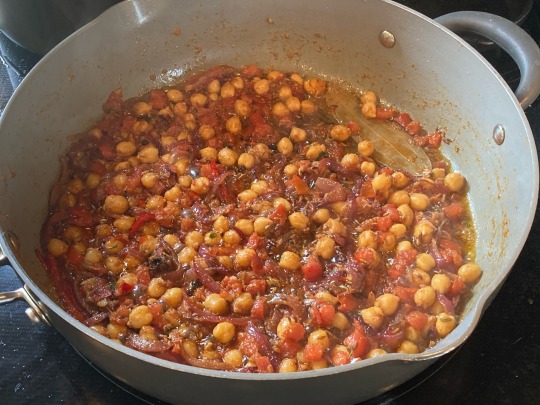
8. Reduce heat to low. Add water, chickpeas, and rice and cook, covered, until rice has absorbed all of the water, 15-20 minutes. If your pan tends to stick or has a thin bottom, stir occasionally.
9. Allow to steam without removing the lid for another 5-10 minutes. Fluff and serve warm. Garnish with sliced almonds, cashews, mint, or lemon as desired.
#vegan#vegetarian#cooking#vegan recipes#chana pulao#rice#basmati rice#garbanzo beans#chickpeas#tomatoes#mint#almonds#Indian#Pakistani#gluten free#Muharram#one pot#under an hour#if you’re using canned beans that is
207 notes
·
View notes
Text
Winter Comforting Stews
And on cold days when you fancy something warming and hearty, these Winter Comforting Stews are just what you are looking for. Slowly simmered meat or fish, in a broth or thick sauce, but always fragrant and tasty! These few recipes, from all over the world, make one relish a a numbing chill!
Poulet D.G. (Chicken E. O.)
Stoofvlees (Dutch Beef and Beer Stew)
Spinach, Sweet Potato and Lentil Dahl (Vegan)
Potée Auvergnate (Ham Hock, Sausage and Vegetable Stew)
Bourguignon Stew with Cheese Dumplings
Poulet Basquaise (Basque Chicken)
Prawn and Trout Bouillabaisse
Sea Bass with Potatoes and Carrots in Saffron Cream
Burns Night Scotch Broth
Petit Salé aux Lentilles (Ham Hock and Lentil Stew)
Lamb Tagine
Sweet Potato Chicken Curry
Hearty Chicken and Dumplings
Chicken Mafé
Beef Stew with Fluffy Dumplings
#Recipe#Recipes#Recipe List#Winter Comforting Stews#Stew#Stews#Stew recipe#Beef Stew recipe#Lamb Stew recipe#Pork Stew recipe#Fish Stew recipe#Chicken Stew recipe#Vegetarian Stew#Vegan Stew#French Cuisine#British and Irish Pub#Belgian and Dutch Kueken#West African and Cameroonian Kitchen#Indian Rasoi#Recipe Box#Winter#Winter recipe#Winter recipes#Winter Warmers
18 notes
·
View notes
Text

Vegetable Balti
Prep Time10 mins Cook Time55 mins Total Time1 hr 5 mins Servings: 4
Ingredients
For the spice mix:
3/4 teaspoon coriander seeds or use ground coriander
1/2 teaspoon nigella seeds or use 1 teaspoon dried onion flakes
1/4 teaspoon cumin seeds or use ground cumin
1/2 teaspoon ground cardamom
1/4 teaspoon fenugreek leaves or 1/8 teaspoon fenugreek seeds
1/8 teaspoon cinnamon
1/2 teaspoon black pepper
1/2 teaspoon paprika
1/2 teaspoon cayenne
For the curry:
2 teaspoons oil
1 cup (160 g) thinly sliced red onions
4 cloves garlic minced
1/2-inch (4 g) ginger minced
1 red bell pepper sliced or use a mix of red and green
1 cup (100 g) cauliflower florets
1 cup (140 g) cubed sweet potato or butternut squash
1 cup (96 g) sliced mushrooms
2 tomatoes chopped small
8-ounce (226.8 g) tomato puree canned also called tomato sauce depending on the brand. Use unseasoned
1 cup (250 ml) water
3/4 teaspoon salt
Instructions
Grind the spices in a spice grinder and set aside.
In a baking dish, add the oil, onion, garlic, and ginger and the spice mix and mix well, and spread it around.
Bake at 400 degrees Fahrenheit (205 c) for 9-11 minutes or until the onion is translucent.
Then add in the veggies, tomatoes, tomato puree, salt, and water and mix well.
Then put the dish back in the oven to bake for 35-45 minutes.
Cover the dish after the first 20 minutes so that the edges don't burn too much. Check if the cauliflower and sweet potato are cooked to preference. Otherwise, bake a little bit longer.
Remove from the oven. Garnish with cilantro and lime juice and serve with Roth flatbread, naan or rice
To make this on stovetop: Heat oil over medium heat in a large skillet. Combine onion garlic ginger and spices and cook until golden. Add tomatoes and cook for a few mins until tender, add the purée, salt, veggies and 1/4 cup water. Cover and cook until veggies are tender (14-17 mins). Stir occasionally. Taste and adjust flavor. Add more water or some creamy milk to adjust consistent if needed, bring to a boil then take off heat.
Notes
To make this creamy, you can use 1 cup of full fat coconut milk instead of water.
You can also add in protein like cubed tofu or chickpeas.
3 notes
·
View notes
Text
Crispy Jackfruit Salad
“Crunchy Jackfruit Salad with Sweet Green Chili Sauce”
This Asian-inspired recipe has an Indian touch; the dressing has a spicy, tangy, and sweet green chili sauce(https://desicomidas.co/2023/09/27/sweet-green-chili-sauce/). This refreshing and vibrant salad is made with a variety of crisp vegetables, accompanied by a flavorful dressing. The key elements of this salad are its crunchy texture and…
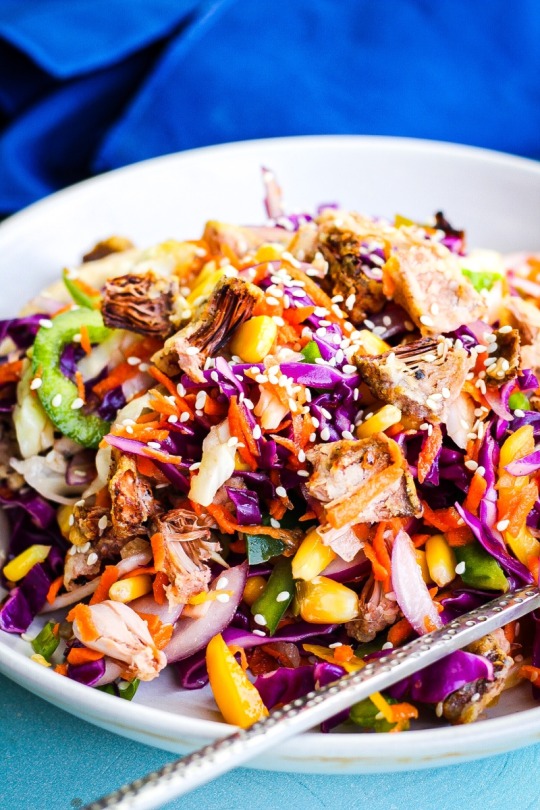
View On WordPress
#asian crunchy salad#chutney#crispy salad#Healthy Salads#indian crunchy salad#indian salad#vegan#vegan recipe#vegan salad#vegetarian recipe
4 notes
·
View notes
Link
PRICE DROPPED!
#food #foodie #yum #yummy #nom #nomnom #hungry #cleaneating #paleo #vegetarian #delish #wine #pizza #pasta #sushi #cocktails #happyhour #foodstagram #burger #eats #GoodEats #Foodography #tasty #delicious #foodporn #breakfast #lunch
#brunch #SundayBrunch #dinner #dessert #recipe #SundayFunday #TacoTuesday #WineWednesday
#dietcookbook #healthcookbook #dietrecipes #Indianfood #vegetarianrecipes #nutrition #satvik #zerooil #specialdiet #weightloss #weightlossrecipes #food #foodie #Vegetariancookbook
7 notes
·
View notes